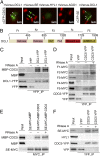CDC5, a DNA binding protein, positively regulates posttranscriptional processing and/or transcription of primary microRNA transcripts
- PMID: 24101471
- PMCID: PMC3808604
- DOI: 10.1073/pnas.1310644110
CDC5, a DNA binding protein, positively regulates posttranscriptional processing and/or transcription of primary microRNA transcripts
Abstract
CDC5 is a MYB-related protein that exists in plants, animals, and fungi. In Arabidopsis, CDC5 regulates both growth and immunity through unknown mechanisms. Here, we show that CDC5 from Arabidopsis positively regulates the accumulation of microRNAs (miRNAs), which control many biological processes including development and adaptations to environments in plants. CDC5 interacts with both the promoters of genes encoding miRNAs (MIR) and the DNA-dependent RNA polymerase II. As a consequence, lack of CDC5 reduces the occupancy of polymerase II at MIR promoters, as well as MIR promoter activities. In addition, CDC5 is associated with the DICER-LIKE1 complex, which generates miRNAs from their primary transcripts and is required for efficient miRNA production. These results suggest that CDC5 may have dual roles in miRNA biogenesis: functioning as a positive transcription factor of MIR and/or acting as a component of the DICER-LIKE1 complex to enhance primary miRNA processing.
Conflict of interest statement
The authors declare no conflict of interest.
Figures






References
-
- Bartel DP. MicroRNAs: Genomics, biogenesis, mechanism, and function. Cell. 2004;116(2):281–297. - PubMed
-
- Voinnet O. Origin, biogenesis, and activity of plant microRNAs. Cell. 2009;136(4):669–687. - PubMed
-
- Vazquez F. Arabidopsis endogenous small RNAs: Highways and byways. Trends Plant Sci. 2006;11(9):460–468. - PubMed
-
- Brodersen P, Voinnet O. The diversity of RNA silencing pathways in plants. Trends Genet. 2006;22(5):268–280. - PubMed
Publication types
MeSH terms
Substances
LinkOut - more resources
Full Text Sources
Other Literature Sources
Molecular Biology Databases
Research Materials

